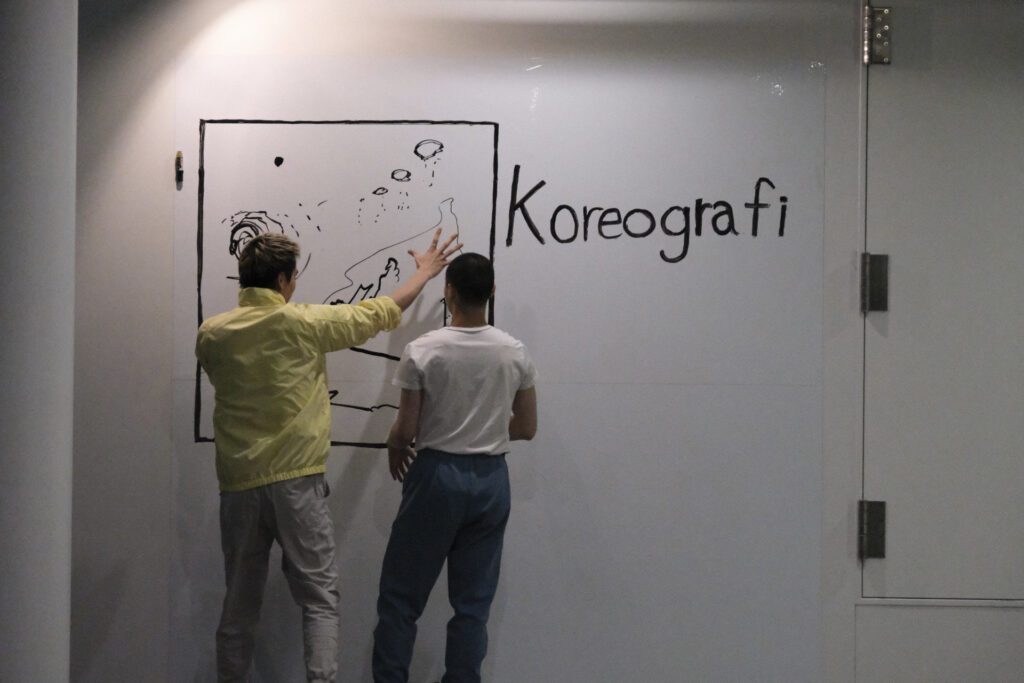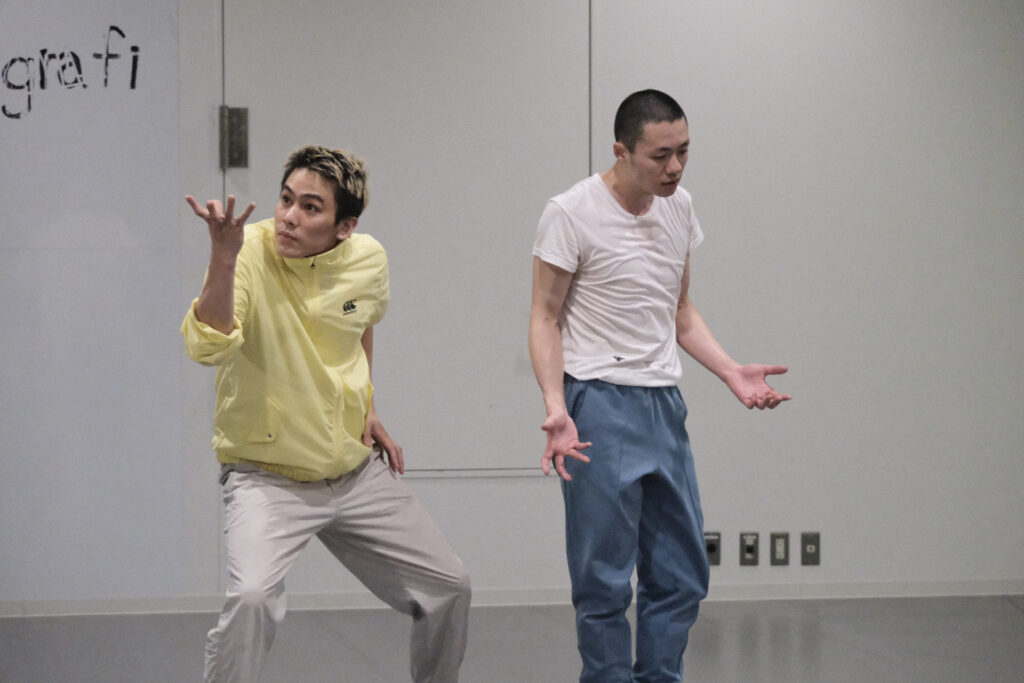Review of Kohei Fujimura’s “Nooooclip” / Expression to Noooclip Expression

Kohei Fujimura New work “Nooooclip” tryout | February 2025 Dance Base Yokohama
0.
Since I started making plays, there is a question I am often asked.
What kind of plays do you make?”
What kind of theater? What kind of theme, what kind of method, what kind of genre, in short, what kind of “expression” is it?
There is nothing I can’t answer. I always write something similar to that when I apply for a grant or submit a profile of my theater company. You could say that I am used to it. Still, I always feel somewhat guilty. I feel that I am somehow sacrificing the movement of the body on stage, the feel of words, the texture of light and sound, all of which are crucial for theater.
So, I always don’t know how to respond to this textbook question, and I can only laugh bitterly.
1.
Kohei Fujimura’s “Noooclip” at Dance Base Yokohama (DaBY) was a work that questioned the very act of “expression” that we are supposed to engage in, not only in dance, but also in theater, film, novels, and other art forms in general. Let us define “expression” as a series of actions such as moving, writing, speaking, and sounding, encompassing some kind of intention, meaning, subject matter, or emotion. Fujimura begins his dance practice by questioning the active nature of the subject or us, who has an intention or awareness of a problem, which is taken for granted in such “expression.
The following quotations are from a collection of texts distributed free of charge to the audience at “Noooclip.
This word “expression” tends to assume the central axis of “I” in most cases. -I feel like 00, think like 00, and express myself” – there I exist as an unshakable absolute, already knowing something, understanding something, and even actively trying to express it in a firm way. I have been told more than once in my involvement in dance, “This is what I want to express in this work,” or “I want to make it clearer what I am expressing,” and so on. Needless to say, however, it is often the case that people are “made to express” rather than “expressing. Our daily words and actions are often the result of the culture, social order, relationships, and other structures behind them. (“Where does the dance come from?”)
He points out that not only the active performer as an “unshakable absolute,” but also the performer who is supposed to be acting as an absolute is often a passive presence who is “made to express” by the culture and social structure surrounding him or her. This is also a perspective on the power structure in collective production, which has become an issue in the performing arts in recent years.
What, in turn, is it that makes dance possible for Fujimura to start dance? In the first place, as long as he chooses the form of expression called “dance” and is on the system of art called “work,” is it really possible to escape from expressing something?

Kohei Fujimura New work “Nooooclip” tryout | February 2025 Dance Base Yokohama
2.
The DaBY space can be characterized at first glance by its two large round pillars. When seated in the auditorium, the columns are flanked on both sides by two speakers. Each of them has a further long and narrow speaker attached to it. There are large doors on the left and right, and a relatively small door on the far side of the front. The wall next to the small door is a whiteboard with a large square and the word “Koreograf” written on it. This is a very simple stage set-up.
At the beginning of the performance, Fujimura and another performer, Asahi Ishikawa, take turns making drawings on the whiteboard. After various abstract shapes and lines are drawn, the two discuss the texture of the lines and the energy they evoke. The drawings are probably improvised, merely lines drawn intuitively in response to what has been drawn before. Once drawn, however, the fine tremor of the line, the texture of the marker, the rise and fall, and the rotation of the line can be found retrospectively.
Drawing, drawing, is the generation of meaninglessness and coincidence beyond one’s own body, and it is also the moment when we witness that the essence of human creativity belongs to emptiness. (…) Dancing is a line that is generated and extinguished in the moment, carved on the wall as an imitator of the body, drifting away from the subject (“Drawing”).
Their hand gestures, which at first mimicked the movements of the line while conversing, somehow became gestures in response to and in response to the other’s gestures, which in turn inspired the other’s movements. Occasionally, there are moments when Ishikawa’s and Fujimura’s choreography resembles each other. However, the similarities rather accentuated the differences in each dancer’s unique body. The incessant and caustic differences triggered the next dance. The dances did not simply disappear. In my mind, as a spectator, several sequences lingered, and before I could find any imitation or meaning in them, the dances flowed and diffused far and wide.
3.
During the opening of the theater and for a while after the performance began, the sounds of the forest were playing from both the left and right speakers. The sounds of birds and small animals, flowing water, wind, and large objects gurgling are layered on top of each other, making me imagine a forest or jungle. When we see a person standing on the stage, just looking into the distance, we tend to assume that he or she looks sad or, judging from the way he or she is dressed, that he or she is returning home from a party. In other words, we try to sense the intention of the work and what it represents.
Similarly, the environmental sounds played on the stage make it easy for us to apply the scenery evoked by the sounds to the stage. In “Nooooclip,” however, the combination of such specific environmental sounds and dancing bodies does not make us see anything. Rather, Fujimura and Ishikawa evade the “observation” by creating gestures one after another, originating from the movement of each other in front of them.
Also, during Fujimura’s solo scene, Ishikawa pulls out a long, thin speaker on the lower side of the room. The sound that had been clear until then suddenly became muffled. The sound in that scene was not ambient sound but a rhythmic electronic sound, but the change in sound quality made me feel that the foundation of the space, which had been stable until then, was shattered.
Noooclip,” or “no-clip,” as the title implies, refers to the state in which the “hit detection,” which detects whether an object (avatar) hits an object (wall or tree) in the in-game world, is turned off or disabled by a bug, allowing the avatar to pass through a blockade. The term “shielding” refers to the state in which an object is able to pass through a shielding object.
In his statement for this work, Fujimura compares this no-clip to the “unnatural and eerie sensation one feels in the real world when a familiar cityscape or well-worn walking path unexpectedly rises up as something estranged”. And that, he says, is the moment when the dance begins.
To be pushed by something and to no-clip behind a wall.
For me, it is the moment when I catch the “Okay, let’s dance” without any guarantees or conditions, and the dance always comes from there. The disparate limbs intuit something and start jumping in all directions with no landing point in sight, like a child mouthing everything in the scenery through a car window.
The moment when a speaker is pulled out and the sound that was strongly affecting the space becomes muffled. Or the moment when new gestures are created while maintaining a loose resemblance to each other’s gestures, body movements, and gazes. The audience is left with all kinds of looks, meanings, and expressions …… In other words, the “hit judgment” that they unconsciously rely on when watching the stage is nullified and no clips are made. Beyond that, the dance and the dancers’ bodies spread out in a swarm of lines that inspire, diffuse, and disappear.

Kohei Fujimura New work “Nooooclip” tryout | February 2025 Dance Base Yokohama
4.
Finally, I would like to mention the performer, Asahi Ishikawa. Ishikawa, who calls herself primarily a theater actor rather than a dancer, is a graduate of the Jack Lecoq International Theater School, which offers mime-based education, and has a body and technique that are clearly different from those of actors accustomed to contemporary spoken word theater in Japan, for example. Of course, he is also distinct from dancers with roots in ballet and other dance genres. In recent years, Ishikawa has participated in many dance works, including those of Kogure Kaho and Hara Saori, but in my opinion, the difference in texture between Ishikawa and the dancer Fujimura was the most striking in this work. In other words, I felt that Ishikawa’s unique body came to the fore.
What we call choreography is not only terribly vague (which is beautiful in itself), but it is also integrated with the myriad of unverifiable creativity that each dancer possesses individually. The body and the choreography are so cohesive that there is no boundary between them, and I don’t know how much of it is choreography and how much is my body and creativity. (From “Drama, Choreography, and Research with Actor Asahi Ishikawa”)
As already noted, when Fujimura and Ishikawa dance together, there are several sequences in which they perform choreography that is similar to each other. Of course, it is not unusual to see dancers’ unique textures in similar movements. However, in “Nooooclip,” the bodies that fiercely creaked and inspired each other gave birth to an “unverbalizable creativity” that went beyond “meaning” and “expression. This is an experience that can only be understood by actually witnessing the performance.
This work was billed as a tryout performance. We are eagerly awaiting this performance.
Justin Yamamoto I et al.
Born in Santa Monica, United States, in 1995. Playwright,
In recent years, while building multiple meta-structures,
His latest work, “Imaginary Sacrifice” (May 3-5, 2025,
In 2025, he began his stage critique activities.


